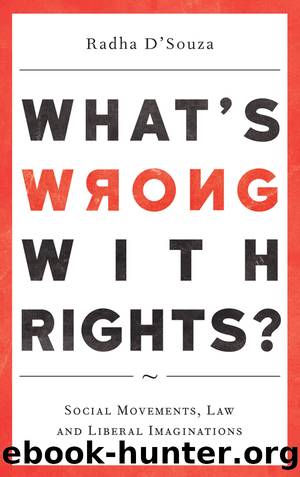What's Wrong with Rights? by Radha D'Souza

Author:Radha D'Souza
Language: eng
Format: epub
ISBN: 9781783717279
Publisher: Book Network Int'l Limited trading as NBN International (NBNi)
THE DEBT CRISIS: A BRIEF TIMELINE
The establishment of intangible properties and their recognition as substantive rights in the 1980s had been a project in the making since WWI. The institutional and legal frameworks for reconstructing capitalism were forged during the world wars and after WWII, as discussed in Chapter 3. Reconstruction included reconstruction of physical infrastructures destroyed by the world wars, institutional infrastructures including markets, states, and property rights, contracts and dispute resolution as well as reconstructing colonial relations disrupted by the imploding empires of the NCI era. Until around 1965 reconstruction of capitalism was state-led through administrative and diplomatic interventions. Many institutions were established during the world wars to support emerging TMF capitalism in the capitalist states. For example, in 1934 during the height of the recession in the US, the government set up the Export Import Bank (EXIM Bank), which was later institutionalised as an independent agency of the US state in 1945 after WWII ended. In the UK, the government established the UK’s Export Credits Guarantee Department (ECGD) in 1919 during the economic recession. After WWI investments in Britain’s colonies to export manufactured goods became a way out of Britain’s own domestic recession.6 These domestic institutions in capitalist states are aligned to IOs in ways that Third World states are not.
Until the mid 1960s capitalist states secured favourable conditions for the overseas activities of their corporations through administrative, state, diplomacy and military initiatives. For example, Third World states received bilateral ‘tied-aid’ which came with conditions that included purchase of goods and services from corporations of the creditor states.7 Transnational Corporations (TNC) expanded rapidly by manufacturing cheap goods for consumption in the US and Europe using cheap labour and natural resources in the Third World and importing high value goods from their home states in the US and EU into Third World states to set up industries to manufacture tradable goods. They received guarantees against losses in Foreign Direct Investments from domestic institutions like the EXIM Bank and ECGD. These administrative, state and diplomacy-led initiatives transformed real relations between Third World states, IEOs and the G7. They could not, however, establish legally recognised international property rights with the entire gamut of contracts, dispute resolution and regulatory mechanisms.
By the late 1960s there was economic turmoil in the belly of post-WWII capitalism, the US. The severe recession around 1968 ended the post-WWII expansion of US manufacturing, banking and investments. Several factors contributed to the economic turmoil such as the plateauing of demand for US goods after post-war reconstruction of Europe under the Marshall Plan, the oil embargo by OPEC countries in 1973, the Yom Kippur War, the Iranian Revolution, the Iran-Iraq War, US deficits and the fall in the value of the US dollar.8 So severe was the crisis that President Nixon unilaterally ended the fixed parity between the US dollar and gold and between the US dollar and other currencies in August 1971 following extreme volatility in the value of the US dollar.9 France threatened to end its own currency’s exchange rates linked to the US dollar.
Download
This site does not store any files on its server. We only index and link to content provided by other sites. Please contact the content providers to delete copyright contents if any and email us, we'll remove relevant links or contents immediately.
| Elections & Political Process | Ideologies & Doctrines |
| International & World Politics | Political Science |
| Public Affairs & Policy | Specific Topics |
| United States |
The Secret History by Donna Tartt(18846)
The Social Justice Warrior Handbook by Lisa De Pasquale(12141)
Thirteen Reasons Why by Jay Asher(8796)
This Is How You Lose Her by Junot Diaz(6794)
Weapons of Math Destruction by Cathy O'Neil(6146)
Zero to One by Peter Thiel(5686)
Beartown by Fredrik Backman(5599)
The Myth of the Strong Leader by Archie Brown(5425)
The Fire Next Time by James Baldwin(5249)
How Democracies Die by Steven Levitsky & Daniel Ziblatt(5128)
Promise Me, Dad by Joe Biden(5087)
Stone's Rules by Roger Stone(5026)
A Higher Loyalty: Truth, Lies, and Leadership by James Comey(4845)
100 Deadly Skills by Clint Emerson(4840)
Rise and Kill First by Ronen Bergman(4704)
Secrecy World by Jake Bernstein(4646)
The David Icke Guide to the Global Conspiracy (and how to end it) by David Icke(4625)
The Farm by Tom Rob Smith(4437)
The Doomsday Machine by Daniel Ellsberg(4416)
